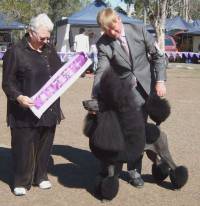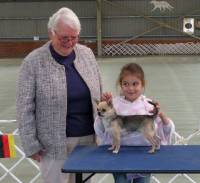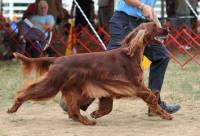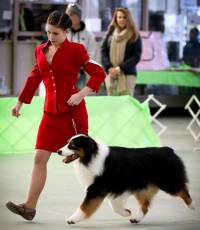Handling Dogs at Shows
 Jane with Fox Terrier (Wire)
Jane with Fox Terrier (Wire)
This page describes the beginnings of Junior Showmanship Competitions and how these helped shape my life. This is followed by the basics of handling dogs at shows, gained from a life-time of personal experience on this vast subject.
History of Junior Showmanship
 Jane with Sealyham
Jane with Sealyham
As I began showing dogs at the age of ten, I witnessed the beginnings of structured Junior Showmanship competitions. Given my own Pure Breed Fox Terrier (Wire) with whom I started showing and handling dogs, we spent weekends at dog shows. As a young handler, I then competed for Junior Showmanship titles. At that time, this competition was later called the 'Tucker Box Juvenile Turnout' because its rules replicated Melbourne's famous 'Garryowen' horse dressage competition. As these Junior Showmanship classes have been conducted annually within the Dog Section of the Royal Melbourne Show since 1948, they were the first structured Junior Handling Competitions held anywhere in the world!
These Competitions have continued ever since. They inspired me to handle both my own and other people's dogs. Dogs and dog showing became my passion. As a late teenage, I infamously travelled to dog shows with my Sealyham Terrier in a box secured to the back of my motor scooter! During the 1960s, even marriage to husband Bob and the birth of our 3 children barely interrupted this passion of exhibiting dogs almost every weekend! Bob and I became actively involved with Airedale Terriers while our children grew up. Passing my passion to my family, at the age of tender age of 8, my elder son Rick won the Junior Showmanship Competition at the 1971 Royal Melbourne Show handling our home-bred Ch Rangeaire Rangitaiki.
 Jane handling an Airedale
Jane handling an Airedale
The Basics of Handling Dogs at Shows
Firstly make certain your dog is clean and correctly presented for its breed for the show ring. With smooth coated dogs, this presentation could be just a mean a good brush, a bath and nail trimming. Some breeds have very specialized coat preparation which you will have to learn from an expert, or maybe the breeder of your dog. Learning to correctly groom your own show dog can very rewarding and a bonding experience between you and your dog. Secondly you must make sure that YOU are comfortable, neat and suitably attired. Best to wear clothes of a colour that contrasts with the colour of your dog, so the dog stands out and does not blend in with the outline of the dog.
Standing your dog
 Poodle (Standard)
Poodle (Standard)
Standing does NOT mean the dog has to stand at attention for extended periods like the guards at Buckingham Palace! Instead, a dog which is somewhat animated always looks better than one which looks like he would rather not be there! The controlled atmosphere of a show ring is really artificial. But means it must be enjoyable for the dog as well as yourself!.
If the dog naturally stands in the 'correct position' for it's breed, best let it stand itself. If, on the other hand a leg or some legs are in the incorrect position, you might have to adjust them, perhaps just one, sometimes just two.
 Chihuahua on judging table
Chihuahua on judging table
There are some smaller breeds that are usually examined on the table while larger breeds are usually examined on the ground. Sometimes it is necessary to 'steady' the dog, other breeds you might have to adjust the tail. With some breeds, it is necessary to get them to use their ears. So teach the dog to learn all about rewards like a treat or a favourite toy. Also get your dog used to being handled by strangers, and having their teeth examined.
Moving your Dog
 Irish Setter
Irish Setter
Before you enter the ring, make certain the dog is comfortable and controlled by whatever lead you have chosen. When entering the ring, you will usually have to travel in a circle and the judge will indicate where to stand your dog. It is necessary for the dog to be moved at a trot with balanced reach and drive at all times. So you have to adjust your speed so the dog is trotting. With large breeds, this usually means you have to run.
 Australian Shepherd
Australian Shepherd
The judge will probably ask you to move your dog 'up and back'. This means away from the judge then turn around, make certain you know where the judge is and move the dog in a straight line back towards him or her. Some judges prefer dogs to be moved in a triangle. This is at the discretion of the judge who may be making use of that particular ring space.
Handling a dog at a dog show is quite an art and more detail is beyond the scope of this website. Whilst there are people who are professional handlers, this article is intended to address the basics of presentation and handling skills required for the novice handler. Showing dogs can be a great social occasion and a great opportunity to share the passion of your breed of dog with other enthusiasts.
References and Further Reading
To learn the basics of how to handle show dogs, it is best to watch it being demonstrated on our DVD 'How to Handle at a Dog Show'